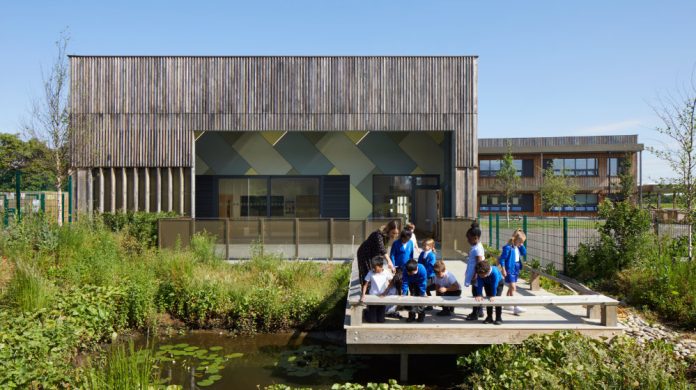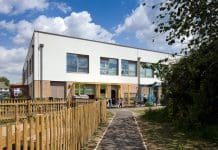The UK’s first Passivhaus Plus school, built by Willmott Dixon in 2019, has won an industry award for zero innovation in educational buildings
Hackbridge Primary School, in the London Borough of Sutton, won in the non-domestic category at the UK Passivhaus Plus Awards 2023. The school was awarded for its outstanding design by Architype, commissioned by Sutton Council.
The UK Passivhaus Awards celebrates buildings that demonstrate exceptional energy efficiency, comfort, and sustainability. According to Passivhaus, Willmott Dixon has demonstrated its commitment to these standards through Doug Drewniak’s work in the Educational Steering Group.
The school can accommodate 244 students, with the potential to expand to 420. The project costs around £9m and used only timber frame construction methods. Construction began in June 2017 and was completed in 2020.
The school surpasses energy targets
The school is a zero-carbon facility, surpassing RIBA’s 2030 energy targets through Passivhaus’s principles of airtightness and insulation. The school now generates more energy annually than it consumes.
The school features a contemporary take on a log cabin, a lightweight timber frame, and Warmcel recycled newspaper-blown insulation. Its green roof showcases diverse plant life, such as sedum, ferns, and wildflowers, which serves as a backdrop for solar PV panels.
The school also surpasses LETI’s 2020 targets for embodied carbon, using half the embodied carbon of a conventional building.
“This is a building that had to be an exemplar for zero carbon and sustainability. The project team rose to the challenge. The result is a beautiful school that celebrates our natural world and inspires children in their learning every day,” said Adam Whiteley, senior project manager for the London Borough of Sutton.
Passivhaus was impressed by the school’s energy consumption
Willmott Dixon has used their Energy Synergy™ approach to optimise the school’s performance. Through this process, they reduced energy consumption by 10,000kWh per year from its peak usage while also increasing energy generation by 40,000kWh per year from its lowest yield. This has led to improved energy efficiency and a significant decrease in carbon emissions.
“The school was built to offer ‘best in class’ energy efficiency and be resilient to climate change, providing a comfortable temperature at all times of the year. Our ongoing monitoring and analysis of the school’s in-use energy performance are helping to further drive down the school’s day-to-day operating costs,” explained Doug Drewniak, senior building performance manager at Willmott Dixon.
“I’m really proud of Willmott Dixon’s part in creating one of the greenest, most efficient schools in the world, working in harmony with its natural surroundings and creating an inspiring and healthy environment for children,” he concluded.














